This was the third year the Center Camp Café occupied its current structure, and the second or third year for nearly everyone on the team, so we felt we really had the opportunity in 2002 to hone what we’d learned from previous experience.
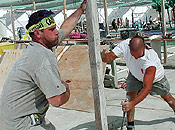 On the construction side, we added a Secondary Construction Manager, who took charge of the coffee shop floors, waterproof shade, counters, staff lounge area, and fence, as well as the stages, the sound booth, and numerous other miscellaneous projects. Among other things, this increase in activity meant that, for the first year, we opened the Café on Monday morning without people hammering overhead while the baristas served coffee. The structure crew did an incredible job of getting the Café itself built, rigged, and shaded in RECORD time. Also, the Transportation crew did a superb job of getting all our “stuff” (and we use a LOT of stuff!) moved over from Black Rock Station. Beyond those functions, Art and Decor finally got the time to shine in 2002.
On the construction side, we added a Secondary Construction Manager, who took charge of the coffee shop floors, waterproof shade, counters, staff lounge area, and fence, as well as the stages, the sound booth, and numerous other miscellaneous projects. Among other things, this increase in activity meant that, for the first year, we opened the Café on Monday morning without people hammering overhead while the baristas served coffee. The structure crew did an incredible job of getting the Café itself built, rigged, and shaded in RECORD time. Also, the Transportation crew did a superb job of getting all our “stuff” (and we use a LOT of stuff!) moved over from Black Rock Station. Beyond those functions, Art and Decor finally got the time to shine in 2002.
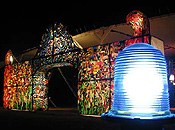 In 2002, we gave full recognition to our status as Burning Man’s largest theme camp. For the first time, we started our Art and Decor planning from the premise that the entire Café was a theme art project. From this thinking emerged Café Island, upon whose shores weary citizens washed up after navigating the turbulent waters of Black Rock City. We surrounded the Café with blue lights to denote the seashore, patting ourselves on the back that this decor element also served the important safety feature of demarcating the structural ground anchors to reduce the likelihood of their being bumped or driven over at night. Facilitated by a close partnership with the Art Department, Finley Fryer contributed his fabulous Main Portal, with images of Floating World creatures beckoning to wandering souls as they approached the safe harbor of the Café. Spacecat created a magical Floating World mural that stretched the full 150-foot length of our back fence. Members of the construction team built ship’s masts at the side portals, where nautical flags spelled out a personal message of welcome. On playa we were blessed with surprise help from a talented team of carpenters, painters, and set dressers who turned miscellaneous scraps and props into a marooned pirate ship filled with treasure, a waterfall cascading over loungeable rocks, tropically fringed benches, and other delights. The Café housed significantly more art installations than ever before, most preplanned, but some impromptu, and all greatly benefiting from the addition of an Artist Liaison to our team roster.
In 2002, we gave full recognition to our status as Burning Man’s largest theme camp. For the first time, we started our Art and Decor planning from the premise that the entire Café was a theme art project. From this thinking emerged Café Island, upon whose shores weary citizens washed up after navigating the turbulent waters of Black Rock City. We surrounded the Café with blue lights to denote the seashore, patting ourselves on the back that this decor element also served the important safety feature of demarcating the structural ground anchors to reduce the likelihood of their being bumped or driven over at night. Facilitated by a close partnership with the Art Department, Finley Fryer contributed his fabulous Main Portal, with images of Floating World creatures beckoning to wandering souls as they approached the safe harbor of the Café. Spacecat created a magical Floating World mural that stretched the full 150-foot length of our back fence. Members of the construction team built ship’s masts at the side portals, where nautical flags spelled out a personal message of welcome. On playa we were blessed with surprise help from a talented team of carpenters, painters, and set dressers who turned miscellaneous scraps and props into a marooned pirate ship filled with treasure, a waterfall cascading over loungeable rocks, tropically fringed benches, and other delights. The Café housed significantly more art installations than ever before, most preplanned, but some impromptu, and all greatly benefiting from the addition of an Artist Liaison to our team roster.
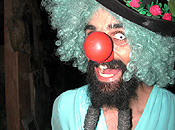 On the performance side, we added a Performance Curator. The schedule featured two evenings of entertainment related to the Floating World theme, and we increased recognition of the growing national and international presence of Burning Man through regional reps by designating specific Regional Nights for the music stage: Tuesday showcased talent from the middle states, Wednesday for eastern states, Thursday for western states, and Sunday for international performers. Volunteers from each geographic area coordinated and curated the entertainment for their night, and the result was a much more varied (and fun!) performance schedule than in the past. In particular, many more groups took advantage of the full Café structure by moving performance from the stage, including trapezes hanging off the structure’s center ring. The Word of Mouth (spoken word) stage also continues to grow in volume and quality of participation, featuring a range of performance from talk shows to poetry to comedy to puppetry. To inform the citizens of Black Rock City of the varied activities at the Café, a brief piece was written in the gate edition of the Black Rock Gazette, and a PSA was recorded before arrival on the playa and provided to Burning Man Information Radio.
On the performance side, we added a Performance Curator. The schedule featured two evenings of entertainment related to the Floating World theme, and we increased recognition of the growing national and international presence of Burning Man through regional reps by designating specific Regional Nights for the music stage: Tuesday showcased talent from the middle states, Wednesday for eastern states, Thursday for western states, and Sunday for international performers. Volunteers from each geographic area coordinated and curated the entertainment for their night, and the result was a much more varied (and fun!) performance schedule than in the past. In particular, many more groups took advantage of the full Café structure by moving performance from the stage, including trapezes hanging off the structure’s center ring. The Word of Mouth (spoken word) stage also continues to grow in volume and quality of participation, featuring a range of performance from talk shows to poetry to comedy to puppetry. To inform the citizens of Black Rock City of the varied activities at the Café, a brief piece was written in the gate edition of the Black Rock Gazette, and a PSA was recorded before arrival on the playa and provided to Burning Man Information Radio.
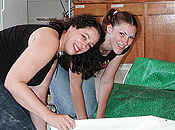 Our other big initiative for 2002 was the formal focus on creating a Café community, following the model of the Lamplighters and now Greeters. With more than 800 volunteers taking part in creating, running, and cleaning up the Café, we recognized that we needed to focus some specific energy on reaching out to these fabulous folks. To begin, we expanded our Volunteer Coordinator team to add an “umbrella” community coordinator and a specific Art and Decor Team coordinator to support the overworked Coffee Shop VC. Then we added an email newsletter called the “Liquid Voice” that provided periodic updates to everyone on our lists. In the off-season, we hosted a series of Café craft parties at the new office, which allowed folks to have fun painting and gluing and glittering and grommeting items for the playa. Some participants in these sessions made it to Burning Man, and some did not. (In fact, we found that some people came to the craft parties specifically because they knew they couldn’t attend the event, and they wanted a way to stay involved and to feel like a part of themselves WOULD be out there with us all.) We also created a Café logo and made up lots of stickers as fun gifts for our volunteers.
Our other big initiative for 2002 was the formal focus on creating a Café community, following the model of the Lamplighters and now Greeters. With more than 800 volunteers taking part in creating, running, and cleaning up the Café, we recognized that we needed to focus some specific energy on reaching out to these fabulous folks. To begin, we expanded our Volunteer Coordinator team to add an “umbrella” community coordinator and a specific Art and Decor Team coordinator to support the overworked Coffee Shop VC. Then we added an email newsletter called the “Liquid Voice” that provided periodic updates to everyone on our lists. In the off-season, we hosted a series of Café craft parties at the new office, which allowed folks to have fun painting and gluing and glittering and grommeting items for the playa. Some participants in these sessions made it to Burning Man, and some did not. (In fact, we found that some people came to the craft parties specifically because they knew they couldn’t attend the event, and they wanted a way to stay involved and to feel like a part of themselves WOULD be out there with us all.) We also created a Café logo and made up lots of stickers as fun gifts for our volunteers.
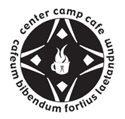
On the playa, we established Café Village, a home away from home for Café workers. Folks who camped there had access to a communal kitchen, a shower, several shared shade structures, and, of course, the raucous hosting of the gang from Muddy Waters who, in addition to supplying our coffee and all the coffee shop equipment, certainly take the “work hard/play hard” motto to heart. At the Café itself, we established our first-ever “welcome table” for volunteers: a place where people could check in, confirm their schedules, ask questions, get oriented, and just generally announce “I’m here and I’m excited to be here!” The result of it all was an unprecedented number of qualified, talented, enthusiastic folks. For several coffee shop shifts, we literally had to turn extra people away (but none of these shifts occurred post-Burn or on Sunday and Monday).
Our documentation efforts for 2002 also grew in scope, as we documented year-round activities and craft parties. We recruited a small team of photographers and videographers from around the world to assist in documentation during the event. The photos in this report and on our web pages, as well as the tremendous record of the Café “Webumentary ” described below are all the fruits of this project.
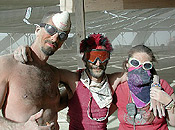 Among all the many many successes, the Café crew experienced only two real problems: Much of the art required special lighting, and the number of Lantern Trees increased. These factors, along with other features like ground anchor lights, the stages, the portal, etc. created unexpected power demands, and our electrical grid didn’t provide consistent service. Each night found the intrepid Lighting Team crawling around, throwing bikes off the lighting boxes, and generally trying to figure out why the lights in one quadrant or the other weren’t working. Also, the huge 4-day post-event dust storm caught us unprepared. Although an incredibly dedicated crew successfully took down and stowed the decor, art, and coffee shop fixtures safely and in record time, the rest of our cleanup crew wasn’t able to wait things out, and we left the DPW with a huge task. We apologize, and we are deeply grateful for their dedication and hard work.
Among all the many many successes, the Café crew experienced only two real problems: Much of the art required special lighting, and the number of Lantern Trees increased. These factors, along with other features like ground anchor lights, the stages, the portal, etc. created unexpected power demands, and our electrical grid didn’t provide consistent service. Each night found the intrepid Lighting Team crawling around, throwing bikes off the lighting boxes, and generally trying to figure out why the lights in one quadrant or the other weren’t working. Also, the huge 4-day post-event dust storm caught us unprepared. Although an incredibly dedicated crew successfully took down and stowed the decor, art, and coffee shop fixtures safely and in record time, the rest of our cleanup crew wasn’t able to wait things out, and we left the DPW with a huge task. We apologize, and we are deeply grateful for their dedication and hard work.
In 2003, look for even more focus on art (both related and unrelated to the event theme), a fabulous nighttime visual presence, deeper development of the Café community, and lots of other things we’ve planned to delight you. You can also expect plenty of things we’ve NOT planned, but which are contributed by BRC citizens in the course of the event week, both installed and ad hoc.
For a full record of Café Island in 2002, from planning through cleanup, see this year’s Café Webumentary, “Greetings From Café Island” which includes photos, video, audio, statistics, and much, much more.
Submitted by,
Dana Harrison, aka BizBabe

